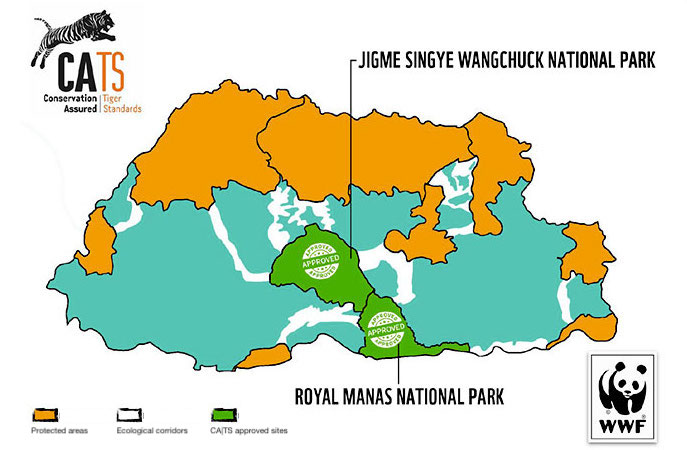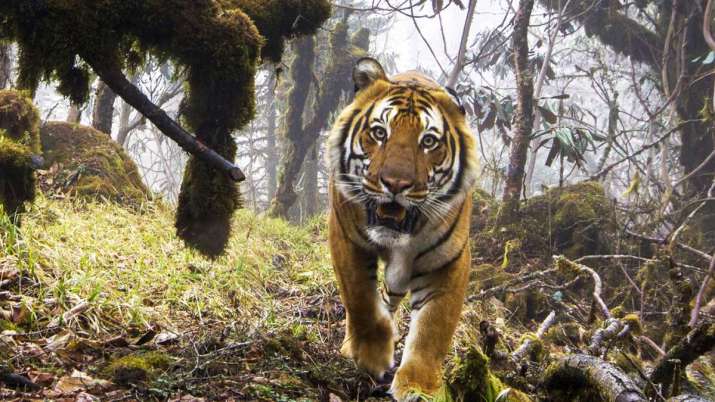Renowned for prioritizing Gross National Happiness over the profit-driven acquisitiveness of unrestrained capitalism, the Buddhist kingdom of Bhutan, nestled high in the rarified air of the eastern Himalaya between northern India and Tibet, is also making strides in the field of wildlife conservation, with articular emphasis on its population of endangered wild tigers.* Two of Bhutan’s national parks this month were awarded Conservation Assured Tiger Standards (CA|TS) accreditation in recognition of their success in this area.
The Royal Manas National Park and Jigme Singye Wangchuck National Park, in central and southern Bhutan, respectively, received CA|TS certification on 3 December—meeting a strict set of criteria that demonstrate that the two parks have attained the highest global operational standards in tiger conservation. CA|TS is an integral part of Tx2—an initiative involving 13 countries, including Bhutan, that aims to double the global population of wild tigers by 2022 (the Year of the Tiger) from 2010 levels to more than 6,000 individuals. In 2016, the world population of wild tigers was estimated at 3,890 individuals, compared with an estimated 100,000 at the beginning of the 20th century. More recent estimates put the global total at 4,683.
There are currently 13 tiger range countries: Bangladesh, Bhutan, Cambodia, China, India, Indonesia, Laos, Malaysia, Myanmar, Nepal, Russia, Thailand, and Vietnam. According to the World Wide Fund for Nature (WWF; formerly the World Wildlife Fund, although the name is still used in the US and Canada), studies have shown that despite recent success in improving tiger numbers, declines in protected areas remain a major risk—in particular due to habitat loss and the poaching of tigers for bush meat, trophies, traditional medicines, and other illegal activities.
Lobzang Dorji, first chair of the CA|TS council and director of Bhutan’s forestry department, described the accreditation as a milestone in Bhutan’s conservation journey, adding: “Being mindful of the significance of area outside protected areas for tiger conservation, Bhutan will soon implement CA|TS in three territorial forest divisions, which are important tiger habitats.” (Kuensel)
In 2015, Bhutan’s wild tiger population was estimated at 103 individuals.** Evidence gathered by conservationists indicates that the population of tigers is slowly growing in the Himalayan kingdom, with new tiger photographs and footprints recorded in different parts of the country pointing to an overall increase in numbers. The Royal Manas National Park, the oldest park in the country, reportedly recorded 64 tigers to date through camera trap surveys, with about 26 sightings believed to be trans-border in nature.
According to the WWF Bhutan, 12 transboundary tigers were recorded in the Transboundary Manas Conservation Area in 2015, up from just four in 2011, due in large part to trans-boundary cooperation with India, and anti-poaching and habitat conservation awareness initiatives among farmers. Tiger conservation is also considered a barometer for the health of the larger ecosystem as a healthy tiger population helps to keep a natural check on herbivore numbers. According to National Tiger Center program director Tshering Tempa, Bhutan’s extensive forest cover could comfortably support 200–250 tigers.

A tiny Vajrayana Buddhist nation*** with a population of fewer than 800,000 people, Bhutan is no stranger to the concept of responsible environmental stewardship that accompanies its conservative approach to economic development: it is renowned as one of the Earth’s rare but essential carbon sinks.**** The kingdom has also taken on a key role in tiger conservation and is taking strides to ensure tiger safety and to encourage natural breeding in a region where poaching and the illegal wildlife trade are rife.
Earlier this year, the deputy chief forestry officer for the Royal Manas National Park, Sithup Lhendup, observed that although it is difficult to ascertain whether the growth in tiger numbers has been due to migration or new births, observations to date indicate an approximate 50:50 split. Future data analyses of demographics and population dynamics are expected to give a clearer picture.
“As we near the target year 2022 [to double the global tiger population], it is time to reflect on how close we are in achieving the goal,” said WWF country director Dechen Dorji. “It also ensures our collective efforts toward tiger conservation.” (Kuensel)
Established in 2013, CA|TS is a conservation accreditation scheme centered on seven conservation management pillars, with 17 elements and associated criteria, intended to encourage tiger conservation areas to meet international standards for effective and long-term tiger conservation. The implementation of these standards helps to ensure that habitats are effectively conserved, managed, and ecologically connected to maintain viable tiger populations. To date, CA|TS has been implemented across 70 sites in seven tiger-range countries. Of 112 global sites surveyed, only 12.5 per cent were able to meet the full CA|TS criteria, and only 13 per cent of tiger conservation areas have met the standards of a global accreditation system.

* Rare Wild Tiger Caught On Camera in Bhutan (Buddhistdoor Global)
** Study: Himalayan Conservation Zones Could Offer Hope for Endangered Tiger Populations (Buddhistdoor Global)
*** Almost 75 per cent of Bhutanese identify as Buddhists, according to data for 2010 from the Washington, DC-based Pew Research Center, with Hinduism accounting for the majority of the remainder. Most of Bhutan’s Buddhists follow either the Drukpa Kagyu or the Nyingma school of Vajrayana Buddhism.
**** Bhutan’s high level of forest cover means that not only has the kingdom met its pledge to remain carbon neutral, it is actually a carbon sink, meaning its forests absorb more carbon dioxide than the country produces.
See more
Tiger conservation efforts recognised (Kuensel)
Doubling tigers in Bhutan’s Royal Manas National Park (WWF)
Tiger numbers increase in Bhutan (thethirdpole.net)
Conservation Assured Tiger Standards
World Wildlife Fund
World Wide Fund for Nature












